Long-term monitoring of health inequalities: January 2021 report
Annual update of the long-term monitoring of health inequalities headline indicators.
This document is part of a collection
Headline indicator of Health Inequalities
Healthy Life Expectancy (HLE)
In 2017-2019, male HLE at birth was 47.0 years for those living in the most deprived areas, 26.0 years lower than those living in the least deprived areas (73.0 years).
Female HLE at birth was 49.5 years for those living in the most deprived areas, 22.1 years lower than those living in the least deprived areas (71.6 years).
The absolute gap in HLE has increased for males since the start of the time series, from 22.5 years in 2013-2015 to 26.0 in 2017-2019, and is currently at its highest point.
The absolute gap in HLE for females, however, has decreased since the start of the time series, from 23.8 years in 2013-2015 to 22.1 years in 2017-2019, and is currently at its lowest point.
Trends in HLE
HLE at birth for males increased between 2013-2015 and 2015-2017 (from 61.8 years to 62.3 years) and has since fallen to its lowest level, 61.7 years in 2017-2019. Similarly for females, HLE increased between 2013-2015 and 2014-2016 (from 62.7 years to 63.3 years) before decreasing to its lowest level in 2017-2019 (61.9 years).
Inequalities in HLE, 2017-2019
HLE is lower for those living in the most deprived areas than for those living in the least deprived areas. In 2017-2019 males in the most deprived areas were, on average, expected to live 26.0 fewer years in good health than those in the least deprived areas (47.0 years vs 73.0 years). Females in the most deprived areas were, on average, expected to live 22.1 fewer years in good health than those in the least deprived areas (49.5 years vs 71.6 years).
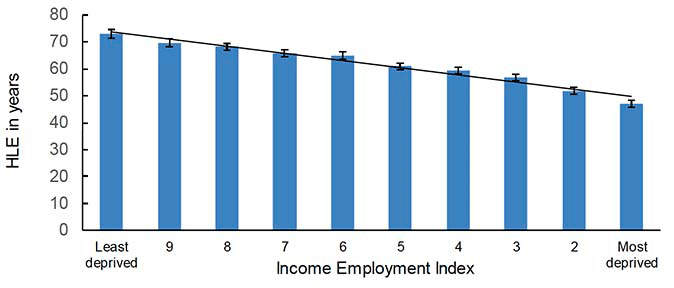
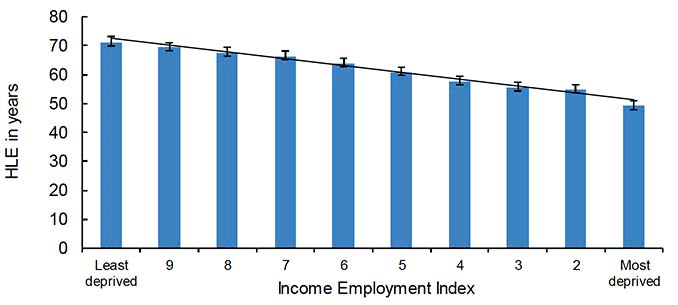
Trends in relative inequalities
The relative index of inequalities (RII) has increased for both males and females since the start of the time series, increasing from 0.38 to 0.43 for males from 0.36 to 0.38 for females between 2013-2015 and 2017-2019.

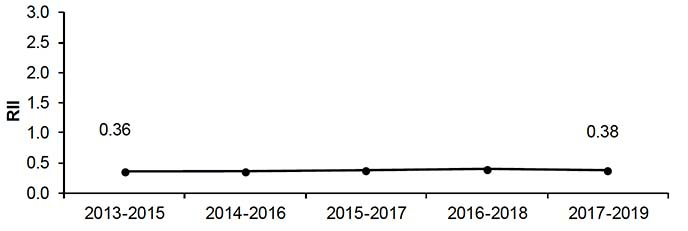
Trends in absolute inequalities
The absolute gap in HLE has increased for males since the start of the time series, from 22.5 years in 2013-2015 to 26.0 in 2017-2019, and is currently at its highest point.
The absolute gap in HLE for females, however, has decreased since the start of the time series, from 23.8 years in 2013-2015 to 22.1 years in 2017-2019, and is currently at its lowest point.
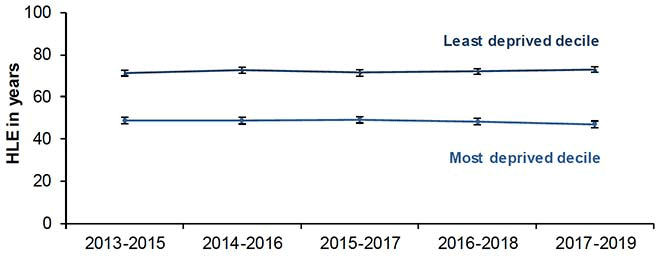
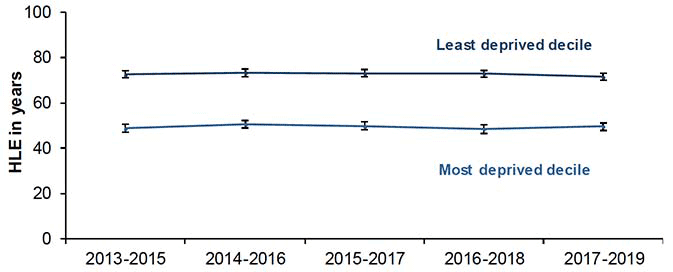
Healthy Life Expectancy and Life Expectancy, 2013-2015 to 2017-2019
Based on HLE and life expectancy (LE) we can estimate the proportion of life spent in good health. In 2017-2019 males were estimated to spend 79.9% of their life in good health, while females were estimated to spend 76.3% of their life in good health.
Males and females in the most deprived areas in Scotland are estimated to spend a lower proportion of their life in good health than those living in the least deprived areas. In 2017-2019 males living in the most deprived areas spent 67.5% of their life in good health, compared to 88.1% for males living in the least deprived areas. Similarly, in 2017-2019, females living in the most deprived areas spent 65.3% of their life in good health, compared to 83.6% for females living in the least deprived areas.
| Confidence Intervals | Confidence Intervals | Proportion of life spent in good health | |||||
|---|---|---|---|---|---|---|---|
| Male HLE in years | 95% LL | Male LE in years | 95% UL | 95% LL | 95% UL | ||
| 2013-2015 | |||||||
| Scotland | 61.8 | 61.4 | 62.2 | 77.1 | 77.0 | 77.2 | 80.2 |
| Most deprived decile | 48.8 | 47.3 | 50.3 | 70.2 | 69.9 | 70.6 | 69.5 |
| Least deprived decile | 71.3 | 70.0 | 72.7 | 82.5 | 82.2 | 82.8 | 86.5 |
| 2014-2016 | |||||||
| Scotland | 62.2 | 61.8 | 62.6 | 77.1 | 77.0 | 77.2 | 80.7 |
| Most deprived decile | 48.8 | 47.2 | 50.3 | 70.0 | 69.7 | 70.3 | 69.7 |
| Least deprived decile | 72.7 | 71.3 | 74.1 | 82.5 | 82.2 | 82.8 | 88.1 |
| 2015-2017 | |||||||
| Scotland | 62.3 | 61.9 | 62.7 | 77.0 | 76.9 | 77.1 | 80.9 |
| Most deprived decile | 49.2 | 47.7 | 50.6 | 69.9 | 69.6 | 70.2 | 70.4 |
| Least deprived decile | 71.4 | 69.9 | 72.9 | 82.6 | 82.3 | 82.9 | 86.5 |
| 2016-2018 | |||||||
| Scotland | 61.9 | 61.5 | 62.3 | 77.1 | 77.0 | 77.2 | 80.3 |
| Most deprived decile | 48.4 | 46.9 | 49.9 | 69.7 | 69.4 | 70.0 | 69.4 |
| Least deprived decile | 72.1 | 70.7 | 73.4 | 82.7 | 82.4 | 83.0 | 87.2 |
| 2017-2019 | |||||||
| Scotland | 61.7 | 61.3 | 62.1 | 77.2 | 77.2 | 77.1 | 79.9 |
| Most deprived decile | 47.0 | 45.4 | 48.6 | 69.6 | 69.3 | 70.0 | 67.5 |
| Least deprived decile | 73.0 | 71.7 | 74.3 | 82.9 | 82.6 | 83.1 | 88.1 |
| Confidence Intervals | Confidence Intervals | Proportion of life spent in good health | |||||
|---|---|---|---|---|---|---|---|
| Female HLE in years | 95% LL | 95% UL | Female LE in years | 95% LL | 95% UL | ||
| 2013-2015 | |||||||
| Scotland | 62.7 | 62.3 | 63.2 | 81.1 | 81.0 | 81.2 | 77.3 |
| Most deprived decile | 48.8 | 47.1 | 50.6 | 76.6 | 76.3 | 76.9 | 63.8 |
| Least deprived decile | 72.6 | 71.1 | 74.2 | 84.7 | 84.5 | 85.0 | 85.7 |
| 2014-2016 | |||||||
| Scotland | 63.3 | 62.9 | 63.8 | 81.1 | 81.1 | 81.2 | 78.0 |
| Most deprived decile | 50.6 | 48.9 | 52.2 | 76.2 | 75.9 | 76.5 | 66.3 |
| Least deprived decile | 73.3 | 71.6 | 74.9 | 84.9 | 84.6 | 85.2 | 86.3 |
| 2015-2017 | |||||||
| Scotland | 62.6 | 62.2 | 63.1 | 81.1 | 81.0 | 81.2 | 77.3 |
| Most deprived decile | 49.9 | 48.2 | 51.7 | 75.8 | 75.5 | 76.1 | 65.9 |
| Least deprived decile | 73.2 | 71.6 | 74.8 | 85.1 | 84.9 | 85.4 | 85.9 |
| 2016-2018 | |||||||
| Scotland | 62.2 | 61.7 | 62.7 | 81.1 | 81.0 | 81.2 | 76.7 |
| Most deprived decile | 48.5 | 46.5 | 50.4 | 75.8 | 75.5 | 76.1 | 63.9 |
| Least deprived decile | 72.8 | 71.3 | 74.3 | 85.2 | 84.9 | 85.5 | 85.5 |
| 2017-2019 | |||||||
| Scotland | 61.9 | 61.5 | 62.4 | 81.1 | 81.2 | 81.1 | 76.3 |
| Most deprived decile | 49.5 | 47.8 | 51.1 | 75.8 | 75.5 | 76.1 | 65.3 |
| Least deprived decile | 71.6 | 70.0 | 73.2 | 85.6 | 85.3 | 85.8 | 83.6 |
Premature mortality (under 75 years)
In 2019, the gap in premature mortality rates between the most and least deprived areas increased to its highest point since 2007 (619.4 per 100,000 and 656.2 per 100,000 respectively), although the gap remains lower than at the start of the time series (648.7 per 100,000 in 1997). Relative inequalities, however, have widened over the long term and are now at the highest point in the time series (1.49).
In 1997, premature mortality rates were 3 times higher in the most deprived areas compared to the least deprived; in 2019, rates were 4 times higher in the most deprived areas.
Trends in premature mortality
Just over 21,500 people in Scotland died before the age of 75 in 2019.
Over the long term there has been a reduction in the mortality rate among under-75s. The European Age-Standardised mortality rate (EASR) among under-75s in 2019 was 425.6 per 100,000 people, a reduction of 35 per cent since 1997 (651.9 per 100,000).
| Year | Number of deaths | Target population size | Rate per 100,000 (EASR) |
|---|---|---|---|
| 1997 | 26,081 | 4,740,269 | 651.9 |
| 1998 | 25,857 | 4,729,975 | 643.3 |
| 1999 | 25,491 | 4,721,298 | 632.5 |
| 2000 | 24,593 | 4,708,667 | 607.3 |
| 2001 | 24,168 | 4,703,661 | 593.1 |
| 2002 | 24,219 | 4,701,958 | 588.9 |
| 2003 | 23,789 | 4,702,431 | 573.4 |
| 2004 | 22,896 | 4,714,233 | 546.2 |
| 2005 | 22,441 | 4,735,320 | 530.3 |
| 2006 | 22,237 | 4,752,425 | 520.4 |
| 2007 | 22,359 | 4,783,452 | 516.8 |
| 2008 | 22,005 | 4,811,453 | 501.3 |
| 2009 | 21,229 | 4,835,007 | 477.0 |
| 2010 | 20,997 | 4,858,058 | 467.4 |
| 2011 | 20,685 | 4,888,316 | 456.1 |
| 2012 | 20,446 | 4,895,114 | 445.3 |
| 2013 | 20,344 | 4,903,074 | 437.5 |
| 2014 | 19,961 | 4,914,362 | 423.2 |
| 2015 | 20,988 | 4,935,283 | 440.5 |
| 2016 | 21,313 | 4,962,391 | 439.7 |
| 2017 | 20,992 | 4,976,829 | 425.2 |
| 2018 | 21,601 | 4,983,364 | 432.0 |
| 2019 | 21,501 | 4,997,455 | 425.6 |
Inequalities in premature mortality, 2019
In 2019, the premature mortality rate in the most deprived areas was 817.6 per 100,000, four times higher than the rate in the least deprived areas (198.2 per 100,000).
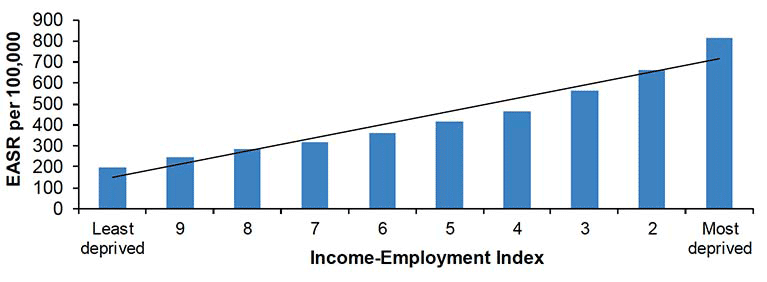
Trends in relative inequalities
Over the longer term, relative inequalities have increased. The RII for 2019 is the highest in the time series at 1.49, compared with 1.00 at the start of the time series in 1997.
Between 1997 and 2019, premature mortality rates declined by 48% in the least deprived areas, but by only 21% in the most deprived areas in Scotland.
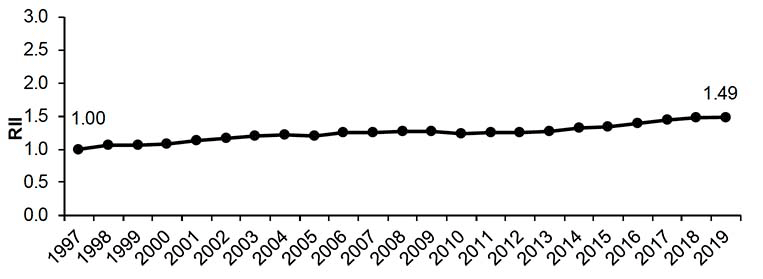
Between 1997 and 2014, premature mortality rates were three times higher in the most deprived areas compared to the least deprived; in the last five years premature mortality rates have been four times higher in the most deprived areas.
Trends in absolute inequalities
Absolute inequalities in premature mortality reached a peak in 2002 (713.4 per 100,000). Between 2002 and 2013 there was a general downward trend. Most notably, the absolute gap between the most and least deprived areas reduced every year between 2007 and 2013 (from 656.2 in 2007 to 536.0 in 2013).
Since 2013 the gap has increased, and is currently at its highest point since 2007 at 619.4 per 100,000.
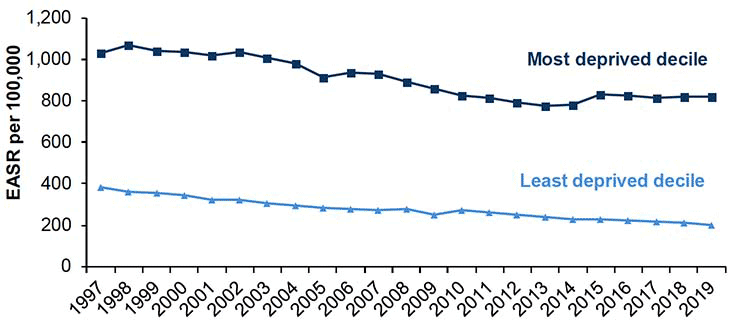
Mental wellbeing – adults aged 16+
The gap in mental wellbeing amongst adults living in the most deprived and least deprived areas has decreased since 2012/2013. There was a difference of 15 percentage points in 2018/2019, the same as the start of the time series in 2008/2009.
Adults in the most deprived areas were three times more likely to have below average wellbeing than adults in the least deprived areas at all time periods except 2012/2013, when they were five time more likely to have below average wellbeing.
Trends in mental wellbeing
The mean score on the Warwick-Edinburgh Mental Wellbeing Scale (WEMWBS) was fairly static between 2008/09 and 2018/19 ranging from 49.6-49.9.
'Below average' wellbeing has been defined as WEMWBS scores of at least one standard deviation below the mean, equivalent to scores of 41 or lower in all years except 2018/2019, which was scores of 40 or lower. The proportion of adults in Scotland who have a below average WEMWBS score has remained at 15% since 2008/2009.
| Mean WEMWBS | Below average wellbeing (indicated by a WEMWBS score of 41 or lower1) | |||||
|---|---|---|---|---|---|---|
| Year | Mean WEMWBS score | Lower 95% confidence limit | Upper 95% confidence limit | Proportion of adults with below average wellbeing (%) | Lower 95% confidence limit (%) | Upper 95% confidence limit (%) |
| 2008/2009 | 49.8 | 49.6 | 50.0 | 15 | 14 | 16 |
| 2010/2011 | 49.9 | 49.7 | 50.1 | 15 | 14 | 16 |
| 2012/2013 | 49.9 | 49.7 | 50.2 | 15 | 14 | 16 |
| 2014/2015 | 49.9 | 49.7 | 50.2 | 15 | 14 | 16 |
| 2016/2017 | 49.8 | 49.6 | 50.1 | 15 | 14 | 16 |
| 2018/2019 | 49.6 | 49.4 | 49.9 | 15 | 14 | 16 |
1. 40 or lower in 2018/2019. 41 or lower in all other years.
Inequalities in mental wellbeing, 2018/2019
In 2018/2019, 24% of adults in the most deprived areas had below average wellbeing, indicated by a WEMWBS score of 40 or lower. This compared to 9% of adults in the least deprived areas.
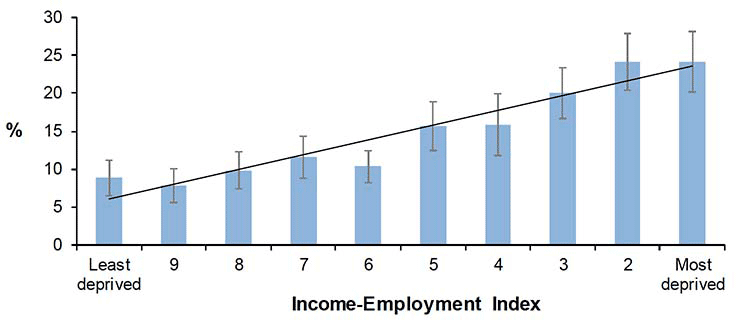
Trends in relative inequalities
The relative index of inequality (RII) in below average wellbeing increased between 2014/2015 and 2018/2019 and is higher than at the start of the time series (1.18 in 2008/2009 compared to 1.32 in 2018/2019).
Adults in the most deprived areas were approximately 3 times more likely to have below average wellbeing compared to those in the least deprived areas at all time periods except 2012/2013, when they were 5 times more likely to have below average wellbeing.
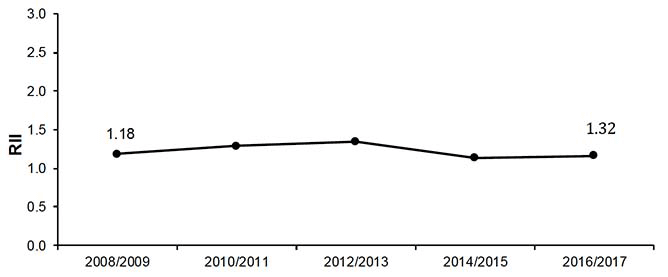
Trends in absolute inequalities
The gap in prevalence of below average wellbeing between those in the most and least deprived areas increased from 15 percentage points in 2008/2009 to a high of 21 percentage points in 2012/2013. It has since decreased over each time period and was 15 percentage points in 2019, the same as at the start of the time series.
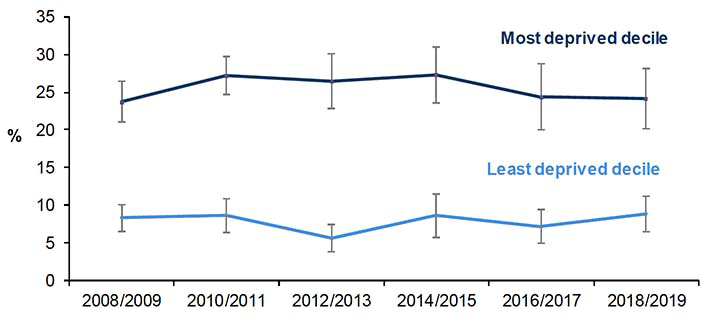
Inequalities in morbidity and mortality indicators
The relative index of inequality (RII) indicates the extent to which health outcomes are worse in the most deprived areas compared to the average throughout Scotland. While comparisons of RII between indicators are possible, they should be made with some caution, in particular where absolute values are significantly higher or lower in the compared indicators or where the measurement scale differs.
The following charts group indicators in this report into broadly comparable categories: the first shows hospital admissions and incidence of conditions for people belonging to the under 75 age group; while the second shows mortality rates in the 45-74 age group for two causes of death.
Although relative inequalities in heart attack hospital admissions have increased in recent years, inequalities have remained highest in alcohol-related admissions throughout the period covered by this report. Inequalities in cancer incidence have remained relatively stable.
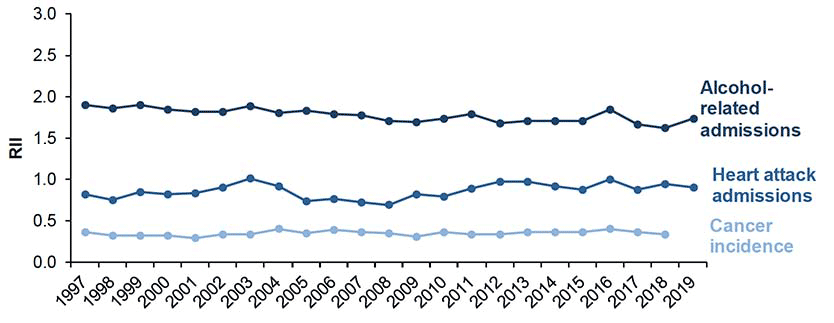
Relative inequalities in CHD deaths among adults aged 45-74 have increased over the long term. Relative inequalities for alcohol-specific deaths have shown more year on year fluctuation over the same period and are currently lower than at the start of the time series (2.02 vs 1.99).
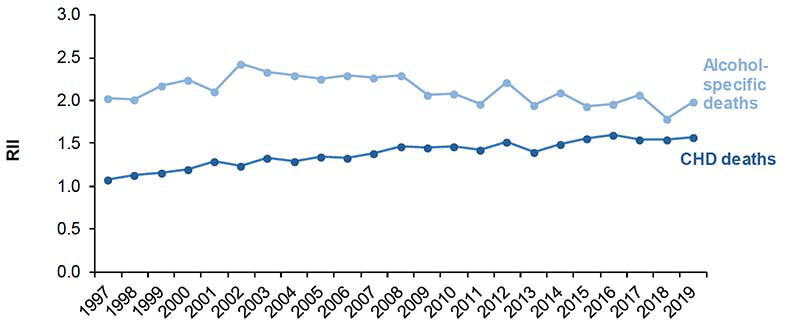
Coronary Heart Disease - first ever hospital admission for heart attack aged under 75 years
Trends in heart attack hospital admissions
In 2019, just over 5,000 new cases of heart attack (for those aged under 75 years) were recorded in Scottish hospitals.
While the rate of admissions in 2019 was 32% lower than in 1997 (98.3 and 145.1 per 100,000), it has increased by 17% since 2018 (83.9 per 100,000).
| Year | Total admissions | Target population size | Rate per 100,000 (EASR) |
|---|---|---|---|
| 1997 | 5,764 | 4,740,269 | 145.1 |
| 1998 | 5,676 | 4,729,975 | 141.5 |
| 1999 | 5,101 | 4,721,298 | 126.6 |
| 2000 | 4,812 | 4,708,667 | 118.4 |
| 2001 | 4,776 | 4,703,661 | 116.9 |
| 2002 | 4,833 | 4,701,958 | 116.6 |
| 2003 | 4,569 | 4,702,431 | 109.0 |
| 2004 | 4,413 | 4,714,233 | 103.9 |
| 2005 | 4,047 | 4,735,320 | 94.2 |
| 2006 | 3,750 | 4,752,425 | 86.4 |
| 2007 | 3,549 | 4,783,452 | 80.4 |
| 2008 | 3,655 | 4,811,453 | 81.7 |
| 2009 | 3,851 | 4,835,007 | 84.9 |
| 2010 | 4,377 | 4,858,058 | 95.4 |
| 2011 | 4,537 | 4,888,316 | 97.7 |
| 2012 | 4,747 | 4,895,114 | 100.8 |
| 2013 | 4,697 | 4,903,074 | 98.8 |
| 2014 | 4,503 | 4,914,362 | 93.4 |
| 2015 | 4,521 | 4,935,283 | 92.8 |
| 2016 | 4,521 | 4,962,391 | 91.5 |
| 2017 | 4,738 | 4,976,829 | 94.9 |
| 2018 | 4,233 | 4,983,364 | 83.9 |
| 2019 | 5,007 | 4,996,827 | 98.3 |
Inequalities in hospital heart attack hospital admissions, 2019
In 2019, the admission rate in Scotland's most deprived areas was more than twice that of those living in the least deprived (147.0 cases per 100,000 compared to 64.4 per 100,000).
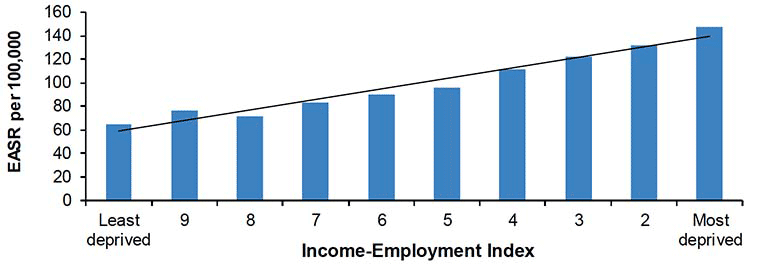
Trends in relative inequalities
Relative inequality levels for heart attack hospital admissions have fluctuated over time, ranging from 0.69-1.01. The RII for 2019 (0.91) is higher than that at the start of the time series (0.82).
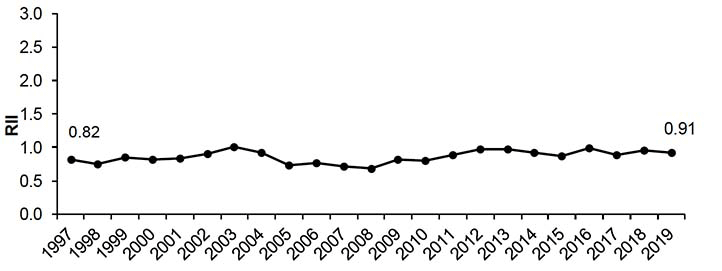
Heart attack hospital admission rates (aged <75) have been 2-3 times higher in the most deprived areas compared to the least deprived areas across the time series.
Trends in absolute inequalities
The absolute gap in hospital admissions between those living in the most and least deprived areas was 82.6 per 100,000 in 2019, lower than at the start of the times series in 1997 when the gap was at its largest (114.6 per 100,000).
However, absolute inequalities have fluctuated over that time, with the gap at its narrowest between 2006 and 2008.
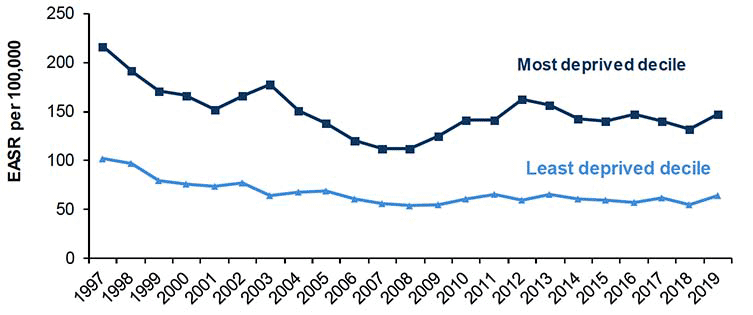
Coronary Heart Disease (CHD) - deaths aged 45-74 years
Trends in CHD deaths
In 2019, over 2,300 deaths amongst those aged 45-74 years were attributed to CHD.
Since 1997, there has been a considerable decrease in CHD deaths amongst the population aged 45-74 years. In 2019, the death rate for this age group was 112.1 per 100,000, less than one third what it was in 1997 and the lowest figure on record.
| Year | Number of deaths | Target population size | Rate per 100,000 (EASR) |
|---|---|---|---|
| 1997 | 5,887 | 1,635,590 | 372.5 |
| 1998 | 5,675 | 1,646,711 | 357.9 |
| 1999 | 5,389 | 1,658,124 | 338.9 |
| 2000 | 4,858 | 1,670,660 | 303.9 |
| 2001 | 4,483 | 1,687,422 | 279.3 |
| 2002 | 4,310 | 1,706,141 | 265.9 |
| 2003 | 4,197 | 1,727,112 | 256.3 |
| 2004 | 3,840 | 1,751,037 | 232.3 |
| 2005 | 3,721 | 1,774,865 | 222.3 |
| 2006 | 3,393 | 1,799,382 | 200.8 |
| 2007 | 3,374 | 1,827,320 | 196.6 |
| 2008 | 3,155 | 1,856,874 | 180.9 |
| 2009 | 2,857 | 1,885,693 | 160.7 |
| 2010 | 2,811 | 1,914,226 | 156.6 |
| 2011 | 2,592 | 1,941,253 | 142.6 |
| 2012 | 2,584 | 1,964,203 | 139.7 |
| 2013 | 2,515 | 1,986,202 | 133.7 |
| 2014 | 2,358 | 2,007,988 | 123.1 |
| 2015 | 2,463 | 2,026,210 | 127.4 |
| 2016 | 2,467 | 2,047,858 | 124.7 |
| 2017 | 2,476 | 2,064,612 | 122.2 |
| 2018 | 2,416 | 2,073,318 | 117.6 |
| 2019 | 2,333 | 2,078,411 | 112.1 |
Inequalities in CHD deaths, 2019
In 2019, the CHD mortality rate was five times greater in Scotland's most deprived areas compared to the least deprived (217.6 compared to 44.7 deaths per 100,000 population).
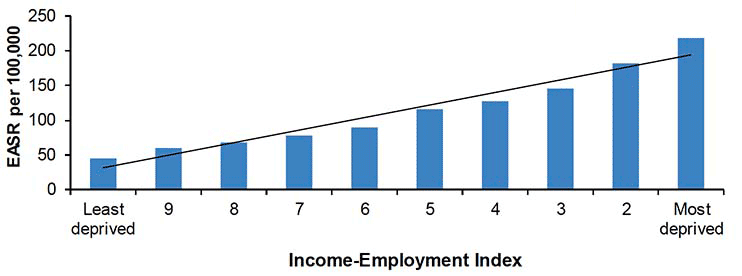
Trends in relative inequalities
Relative inequalities in CHD deaths have increased over the longer term. The RII figures for the last five years have been the highest in the time series, ranging from 1.54-1.60.
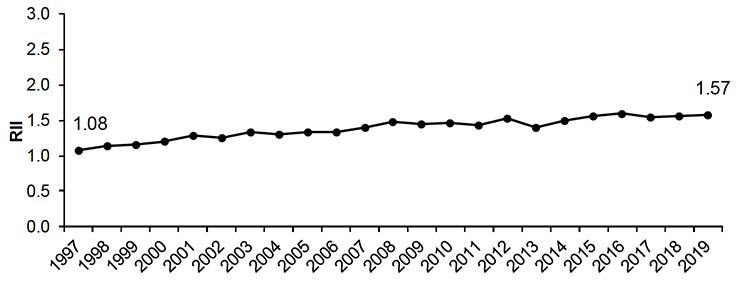
In the last ten years, CHD mortality rates have typically been 4-5 times higher in the most deprived areas compared to the least deprived areas. This is higher than at the start of the times series when CHD mortality rates were typically 3-4 times higher.
Trends in absolute inequalities
In contrast to relative inequalities, absolute inequality between those living in the most deprived areas and those living in the least deprived areas has reduced over the longer term from a high of 390.1 per 100,000 in 1998. The current gap is less than half what it was in 1998 (172.9 per 100,000 in 2019).
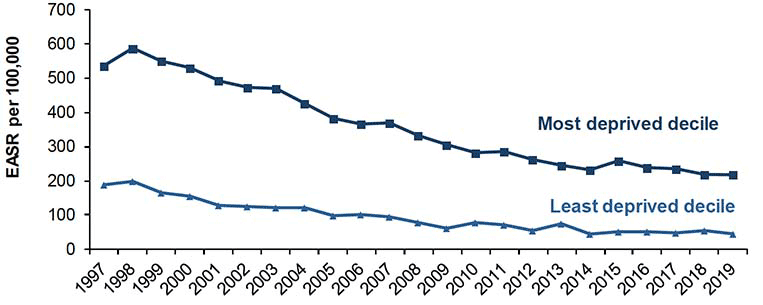
Cancer incidence rate aged under 75 years
Trends in cancer incidence
In 2018, there were over 22,500 new cases of cancer among people aged under 75.
Cancer incidence among people aged under 75 has fluctuated over the time series. It showed a general decrease from a high of 452.7 per 100,000 in 1996 to a low of 417.5 per 100,000 in 1999, before showing an overall increase until 2009 (446.6 per 100,000). Since 2009 cancer incidence rates decreased overall until 2017, before peaking in 2018 to a similar level to 1997 (449.1 per 100,000).
| Year | Number of new cases | Target population size | Rate per 100,000 (EASR) |
|---|---|---|---|
| 1996 | 18,128 | 4,754,906 | 452.7 |
| 1997 | 17,167 | 4,740,269 | 427.4 |
| 1998 | 17,109 | 4,729,975 | 424.3 |
| 1999 | 16,914 | 4,721,298 | 417.5 |
| 2000 | 17,138 | 4,708,667 | 420.6 |
| 2001 | 17,147 | 4,703,661 | 418.9 |
| 2002 | 17,530 | 4,701,958 | 423.6 |
| 2003 | 17,574 | 4,702,431 | 420.8 |
| 2004 | 18,159 | 4,714,233 | 430.3 |
| 2005 | 17,987 | 4,735,320 | 421.9 |
| 2006 | 18,167 | 4,752,425 | 423.3 |
| 2007 | 18,775 | 4,783,452 | 430.8 |
| 2008 | 19,449 | 4,811,453 | 439.7 |
| 2009 | 19,999 | 4,835,007 | 446.6 |
| 2010 | 20,015 | 4,858,058 | 441.9 |
| 2011 | 20,208 | 4,888,316 | 441.3 |
| 2012 | 20,296 | 4,895,114 | 436.8 |
| 2013 | 20,598 | 4,903,074 | 437.7 |
| 2014 | 21,064 | 4,914,362 | 442.4 |
| 2015 | 20,888 | 4,935,283 | 433.5 |
| 2016 | 20,980 | 4,962,391 | 429.2 |
| 2017 | 21,197 | 4,976,829 | 426.5 |
| 2018 | 22,549 | 4,983,364 | 449.1 |
Inequalities in cancer incidence, 2018
In 2018, there were 541.6 cases of cancer per 100,000 people in the most deprived areas, compared to 408.9 cases per 100,000 in the least deprived areas.
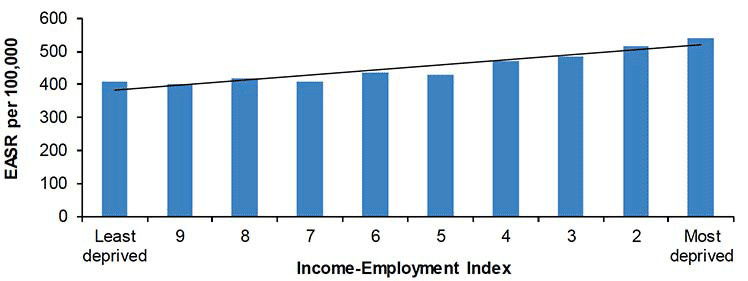
Cancer incidence is more common in the most deprived areas of Scotland. However, this is not the case for all types of cancer.[1] This is driven in part by variations in screening uptake, leading to socially patterned rises in cancer incidence and, in turn, cancer survival for some types of cancer in the least deprived areas.
As has been the case in previous years, of the most common types of cancer, the absolute gap between most and least deprived areas was largest for cancer of the trachea, bronchus and lung (2018 rates were 120.9 and 32.9 per 100,000 population in the most and least deprived areas respectively).
Trends in relative inequalities
Changes in the relative index of inequality over time have been minimal and show no clear pattern, with the rate fluctuating between 0.29 and 0.40.
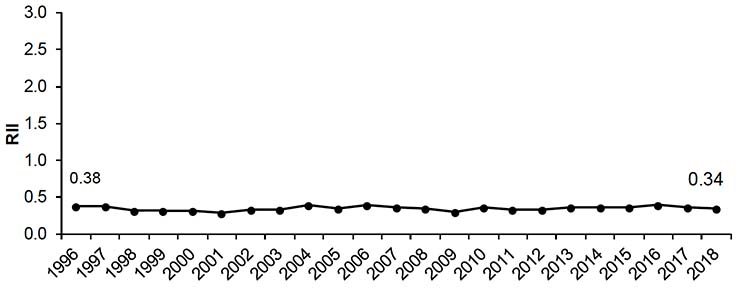
Trends in absolute inequalities
Absolute inequality levels in cancer incidence have fluctuated over time, ranging from 122.1 to 178.2. Rates in both the least and most deprived areas of Scotland have shown no clear pattern.
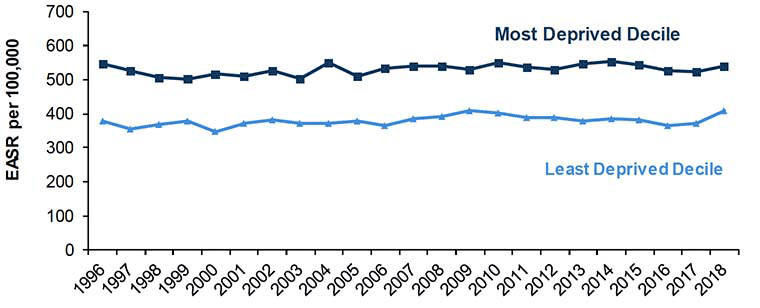
The gap between the most and least deprived decile in 2018 (132.7 per 100,000) was the lowest it's been since 2009 (122.1 per 100,000). However, this reduction has been driven by an increase in rates in the least deprived decile.
Alcohol-related hospital admissions aged under 75 years
Trends in alcohol-related admissions
The hospital admission rate for alcohol-related conditions amongst those aged under 75 years has fluctuated over time and was lower in 2019 than at the start of the time series (224.6 cases per 100,000 in 2019, compared to 289.8 in 1996).
| Year | Number of admissions | Target population size | Rate per 100,000 (EASR) |
|---|---|---|---|
| 1996 | 12,787 | 4,754,906 | 289.8 |
| 1997 | 12,918 | 4,740,269 | 292.6 |
| 1998 | 13,316 | 4,729,975 | 300.7 |
| 1999 | 13,217 | 4,721,298 | 298.2 |
| 2000 | 12,786 | 4,708,667 | 286.6 |
| 2001 | 13,469 | 4,703,661 | 300.3 |
| 2002 | 13,492 | 4,701,958 | 299.9 |
| 2003 | 12,996 | 4,702,431 | 290.0 |
| 2004 | 14,084 | 4,714,233 | 312.5 |
| 2005 | 13,346 | 4,735,320 | 293.8 |
| 2006 | 13,595 | 4,752,425 | 295.3 |
| 2007 | 14,641 | 4,783,452 | 313.5 |
| 2008 | 14,222 | 4,811,453 | 302.3 |
| 2009 | 12,891 | 4,835,007 | 272.9 |
| 2010 | 12,307 | 4,858,058 | 258.7 |
| 2011 | 12,264 | 4,888,316 | 256.2 |
| 2012 | 11,556 | 4,895,114 | 240.9 |
| 2013 | 11,225 | 4,903,074 | 236.8 |
| 2014 | 10,779 | 4,914,362 | 223.6 |
| 2015 | 10,467 | 4,935,283 | 216.2 |
| 2016 | 10,770 | 4,962,391 | 219.4 |
| 2017 | 10,644 | 4,976,829 | 218.1 |
| 2018 | 10,662 | 4,983,364 | 217.6 |
| 2019 | 11,115 | 4,997,455 | 224.6 |
Inequalities in alcohol-related hospital admissions, 2019
In 2019, alcohol-related admissions were 5 times higher in the most deprived
areas of Scotland compared to the least (471.5 compared to 93.9 cases per 100,000).
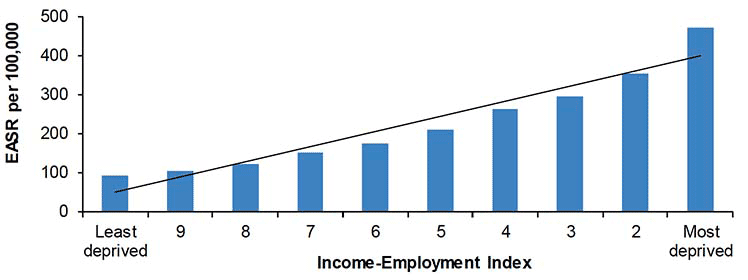
Trends in relative inequalities
There has been a general downward trend observed in relative inequalities for alcohol-related hospital admissions since 1996. However, there has been some fluctuation including an increase in 2016 when the RII was 1.85, the highest rate since 2003. The figure for 2019 was 1.73.
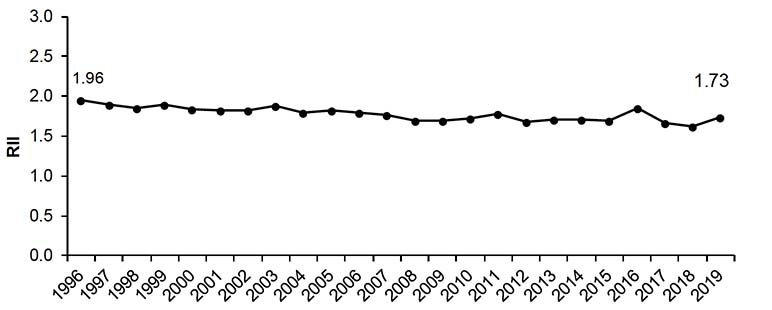
In 1996, alcohol-related admission rates were 7 times higher in the most deprived areas compared to the least deprived. These rates have ranged between 4 and 6 times higher since 2003.
Trends in absolute inequalities
Absolute inequality in alcohol-related admissions has generally reduced over time, due to a reduction in admissions in the most deprived areas. The gap was widest at the start of the time series in 1996 (613.0 per 100,000) and reduced to its lowest level in 2018 (328.3 per 100,000). It increased slightly in 2019 to 377.6 per 100,000.
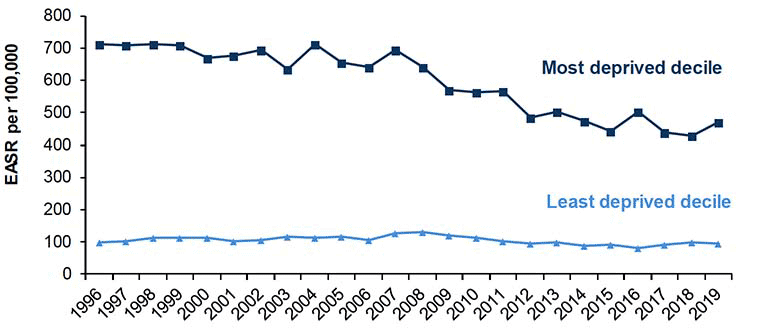
Alcohol-specific deaths aged 45-74 years
Trends in alcohol-specific deaths
The alcohol-specific death rate among those aged 45-74 years has fluctuated over the time series. There was an overall increase between 1997 and 2006 (increasing from 38.5 per 100,000 to 61.3 per 100,000) followed by a general downward trend until 2013 (38.6 per 100,000) when the rate was similar to the start of the time series. Since 2013, the alcohol-specific mortality rate has increased slightly, ranging from 38.4-44.0 per 100,000. The rate in 2019 was 38.4 per 100,000, similar to the rate at the start of the time series.
| Year | Number of deaths | Target population size | Rate per 100,000 (EASR) |
|---|---|---|---|
| 1997 | 636 | 1,635,590 | 38.5 |
| 1998 | 695 | 1,646,711 | 41.9 |
| 1999 | 761 | 1,658,124 | 45.2 |
| 2000 | 873 | 1,670,660 | 52.1 |
| 2001 | 957 | 1,687,422 | 56.7 |
| 2002 | 1,049 | 1,706,141 | 61.3 |
| 2003 | 1,053 | 1,727,112 | 60.9 |
| 2004 | 1,015 | 1,751,037 | 57.6 |
| 2005 | 1,056 | 1,774,865 | 59.3 |
| 2006 | 1,105 | 1,799,382 | 61.3 |
| 2007 | 1,002 | 1,827,320 | 54.6 |
| 2008 | 1,019 | 1,856,874 | 54.8 |
| 2009 | 905 | 1,885,693 | 47.9 |
| 2010 | 927 | 1,914,226 | 48.3 |
| 2011 | 871 | 1,941,253 | 45.1 |
| 2012 | 752 | 1,964,203 | 38.2 |
| 2013 | 769 | 1,986,202 | 38.6 |
| 2014 | 808 | 2,007,988 | 40.2 |
| 2015 | 840 | 2,026,210 | 41.4 |
| 2016 | 898 | 2,047,858 | 43.7 |
| 2017 | 910 | 2,064,612 | 44.0 |
| 2018 | 898 | 2,073,318 | 43.2 |
| 2019 | 801 | 2,078,664 | 38.4 |
Inequalities in alcohol-specific deaths, 2019
The alcohol-specific death rate (for those aged 45-74 years) in Scotland's most deprived areas is 9 times higher than that observed in the least deprived areas (96.0 compared to 10.2 per 100,000 population).
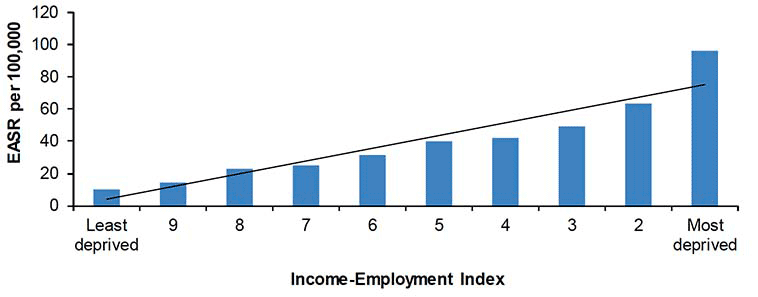
Trends in relative inequalities
Relative inequalities in alcohol-specific deaths have fluctuated across the time series, ranging from 1.79 to 2.43. The RII in 2019 was similar to the start of the times series in 1997 (1.99 and 2.02 respectively).
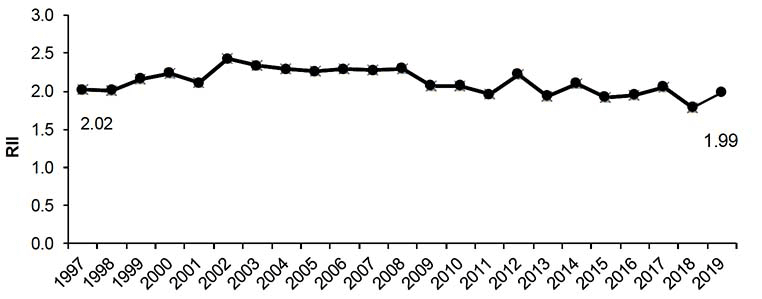
Over time the relative range in death rates between the most and least deprived areas has fluctuated ranging from 5 to 14 times higher in the most deprived areas.
Trends in absolute inequalities
Although the rate of alcohol-specific deaths in the least deprived areas has remained reasonably static since 1997, there has been considerable change in the rate in the most deprived areas. This has largely driven changes in the absolute gap.
Following an increase in the gap between the alcohol-specific mortality rate in the most and least deprived areas of Scotland, from 93.7 to 184.7 per 100,000 between 1997 and 2002, there has been general downward trend, with a rate of 85.8 per 100,000 in 2019.
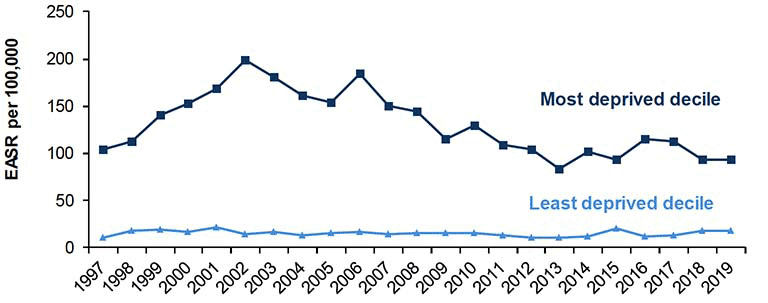
All-cause mortality aged 15-44 years
Trends in all-cause mortality aged 15-44
There were over 2,300 deaths of people aged 15-44 in Scotland in 2019.
There was an overall decrease in the mortality rate from the start of the time series to 2014, when rates reached a low of 96.8 per 100,000. Since then, the mortality rate of those aged 15-44 has risen and in 2019 it was similar to the rate in 1997 (119.8 per 100,000 and 116.3 per 100,000 respectively).
| Year | Number of all-causes deaths | Target population size | Rate per 100,000 (EASR) |
|---|---|---|---|
| 1997 | 2,440 | 2,158,030 | 116.3 |
| 1998 | 2,507 | 2,142,787 | 119.4 |
| 1999 | 2,507 | 2,129,794 | 119.0 |
| 2000 | 2,501 | 2,118,568 | 118.7 |
| 2001 | 2,509 | 2,111,242 | 119.0 |
| 2002 | 2,566 | 2,102,670 | 122.0 |
| 2003 | 2,461 | 2,094,408 | 116.9 |
| 2004 | 2,409 | 2,088,563 | 114.7 |
| 2005 | 2,305 | 2,091,415 | 109.3 |
| 2006 | 2,482 | 2,091,581 | 118.3 |
| 2007 | 2,461 | 2,097,902 | 117.5 |
| 2008 | 2,443 | 2,096,495 | 117.5 |
| 2009 | 2,389 | 2,092,065 | 115.1 |
| 2010 | 2,229 | 2,087,635 | 108.6 |
| 2011 | 2,262 | 2,092,311 | 110.8 |
| 2012 | 2,071 | 2,077,902 | 102.8 |
| 2013 | 1,990 | 2,064,867 | 100.1 |
| 2014 | 1,904 | 2,053,897 | 96.8 |
| 2015 | 1,976 | 2,053,401 | 101.2 |
| 2016 | 2,194 | 2,054,055 | 112.5 |
| 2017 | 2,068 | 2,048,063 | 107.1 |
| 2018 | 2,220 | 2,044,305 | 114.5 |
| 2019 | 2,331 | 2,053,086 | 119.8 |
The deaths of those age 15-44 in 2019 included: 404 probable suicides, 29 deaths from assault and 753 drug-related deaths. While the rates of probable suicide in this age group had generally been declining in recent years there was an increase in both 2018 and 2019, to 19.7 per 100,00 in 2019, the highest figure since 2011 (20.5 per 100,000). Rates of death from assault have increased slightly from a low of 1.0 per 100,000 in 2014, but have generally been lower in the last decade that at the start of the series. Drug-related deaths have shown large increases since the beginning of the time series in 1997. In 2019, the drug-related death rate was 38.4 per 100,000, this compares with 8.9 per 100,000 in 1997.
| Deaths from assault | Drug related deaths | Suicides | ||||
|---|---|---|---|---|---|---|
| Year | Number | EASR per 100,000 | Number | EASR per 100,000 | Number | EASR per 100,000 |
| 1997 | 56 | 2.6 | 196 | 8.9 | 518 | 23.9 |
| 1998 | 65 | 3.0 | 227 | 10.6 | 526 | 24.4 |
| 1999 | 86 | 4.0 | 274 | 12.9 | 529 | 24.7 |
| 2000 | 60 | 2.9 | 268 | 12.7 | 541 | 25.6 |
| 2001 | 63 | 3.0 | 289 | 13.8 | 531 | 25.3 |
| 2002 | 76 | 3.6 | 345 | 16.7 | 539 | 25.7 |
| 2003 | 71 | 3.4 | 282 | 13.6 | 456 | 21.8 |
| 2004 | 78 | 3.8 | 311 | 15.2 | 475 | 22.7 |
| 2005 | 50 | 2.3 | 277 | 13.4 | 436 | 21.0 |
| 2006 | 83 | 4.0 | 350 | 17.1 | 435 | 20.9 |
| 2007 | 54 | 2.6 | 392 | 19.1 | 453 | 21.8 |
| 2008 | 53 | 2.5 | 477 | 23.3 | 480 | 23.4 |
| 2009 | 47 | 2.3 | 436 | 21.3 | 432 | 20.8 |
| 2010 | 54 | 2.6 | 384 | 18.9 | 423 | 20.5 |
| 2011 | 53 | 2.6 | 454 | 22.5 | 420 | 20.5 |
| 2012 | 37 | 1.9 | 416 | 20.8 | 375 | 18.3 |
| 2013 | 35 | 1.7 | 354 | 17.9 | 356 | 17.7 |
| 2014 | 22 | 1.0 | 416 | 21.1 | 309 | 15.4 |
| 2015 | 28 | 1.4 | 442 | 22.8 | 306 | 15.3 |
| 2016 | 34 | 1.7 | 568 | 29.2 | 329 | 16.2 |
| 2017 | 40 | 2.0 | 581 | 30.1 | 305 | 15.1 |
| 2018 | 28 | 1.4 | 723 | 37.3 | 370 | 18.3 |
| 2019 | 29 | 1.4 | 753 | 38.4 | 404 | 19.7 |
Inequalities in all-cause mortality aged 15-44, 2019
The mortality rate amongst people aged 15-44 years was 8 times higher in the most deprived areas (295.9 per 100,000) compared to the least deprived (38.0 per 100,000) in 2019.
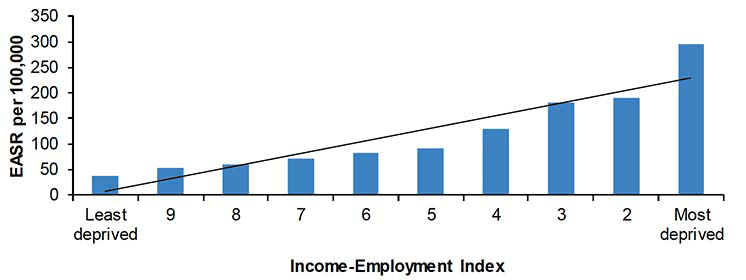
Trends in relative inequalities
There has been an overall increase in relative inequalities over time and they are currently at their highest point in the time series (2.11).
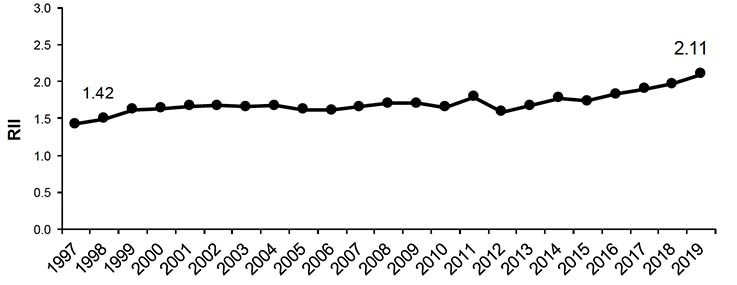
Between 1997 and 2017, death rates ranged from 4-7 times higher in the most deprived areas compared to the least deprived. In 2018 and 2019 deaths for those aged 15-44 years were 8 times higher in the most deprived areas compared to the least deprived areas.
Trends in absolute inequalities
The absolute gap between those living in the most and least deprived areas in all-cause mortality reached its lowest level in 2013 (a gap of 159.6 per 100,000). The gap has increased in each year since 2013 and is currently at its highest point in the time series at 257.9 per 100,000 in 2019.
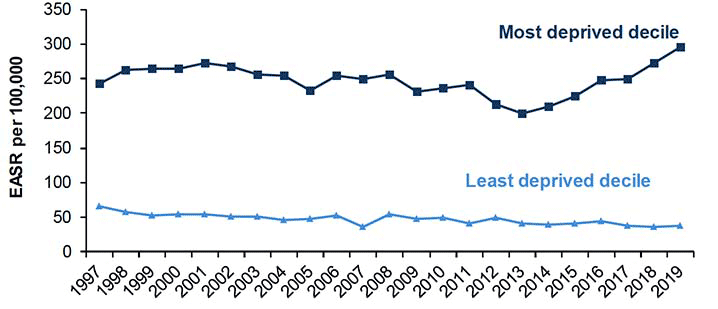
Low Birthweight
Trends in low birthweight
Over 2,600 low birthweight babies were born in Scotland in 2019.
The percentage of babies born with a low birthweight remained fairly stable across the time series, ranging from 5.0 – 6.0%
| Year | Number of low birthweight babies | Target population size | % of live singleton births |
|---|---|---|---|
| 1996 | 3,066 | 55,861 | 5.5 |
| 1997 | 3,149 | 56,982 | 5.5 |
| 1998 | 3,108 | 55,152 | 5.6 |
| 1999 | 3,098 | 52,726 | 5.9 |
| 2000 | 2,906 | 51,057 | 5.7 |
| 2001 | 2,848 | 49,744 | 5.7 |
| 2002 | 2,910 | 48,950 | 5.9 |
| 2003 | 3,026 | 50,069 | 6.0 |
| 2004 | 3,030 | 51,807 | 5.8 |
| 2005 | 3,058 | 51,436 | 5.9 |
| 2006 | 2,939 | 52,467 | 5.6 |
| 2007 | 3,095 | 55,271 | 5.6 |
| 2008 | 3,134 | 56,925 | 5.5 |
| 2009 | 2,893 | 56,107 | 5.2 |
| 2010 | 2,816 | 56,123 | 5.0 |
| 2011 | 2,946 | 56,037 | 5.3 |
| 2012 | 2,775 | 55,369 | 5.0 |
| 2013 | 2,684 | 53,219 | 5.0 |
| 2014 | 2,773 | 54,396 | 5.1 |
| 2015 | 2,819 | 52,845 | 5.3 |
| 2016 | 2,762 | 52,424 | 5.3 |
| 2017 | 2,840 | 50,830 | 5.6 |
| 2018 | 2,690 | 49,259 | 5.5 |
| 2019 | 2,622 | 47,258 | 5.5 |
Inequalities in low birthweight 2019
In 2019, 8.5% of live singleton births in the most deprived areas were recorded as low birthweight. This is more than double the percentage in the least deprived areas (3.8%).
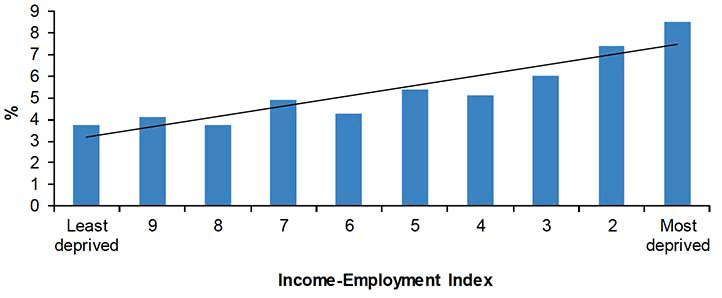
Trends in relative inequalities
Relative inequalities in low birthweight were higher in 2019 than those observed at the start of the time series (0.93 and 0.84 respectively). The RII values between 1997 and 2006 tended to be higher than those observed in the last decade.
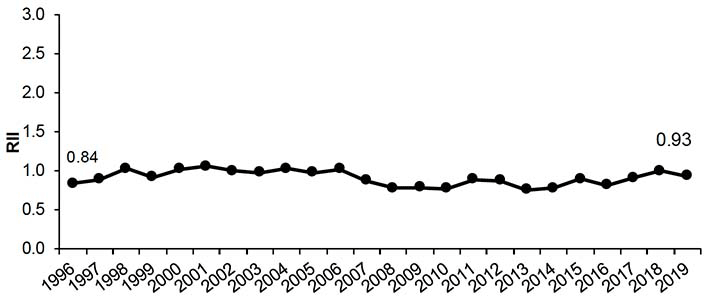
Trends in absolute inequalities
Overall, the absolute gap between the most and least deprived areas has reduced from its widest point in 2004 (5.7 percentage points). However, the gap has increased in most years since 2013 from 3.2 percentage points to 4.8 percentage points in 2019.
The narrowing and widening of the gap has tended to be driven by changes in the most deprived decile, as the least deprived decile has remained broadly stable since the beginning of the time series.
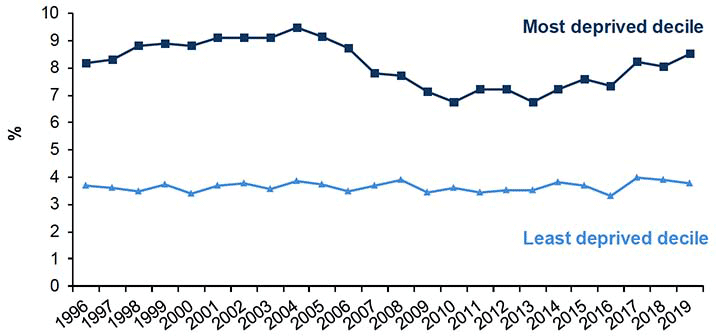
Healthy Birthweight
Trends in healthy birthweight babies
In each year of the time series, either 89% or 90% of babies have been of healthy birthweight. For the past eight years the value has been 90%.
| Year | Number appropriate for gestational age1 | Target population size1 | % of live singleton births |
|---|---|---|---|
| 1996 | 49,989 | 55,759 | 89.7 |
| 1997 | 51,113 | 56,895 | 89.8 |
| 1998 | 49,303 | 55,075 | 89.5 |
| 1999 | 47,048 | 52,655 | 89.4 |
| 2000 | 45,292 | 50,978 | 88.8 |
| 2001 | 44,355 | 49,666 | 89.3 |
| 2002 | 43,571 | 48,853 | 89.2 |
| 2003 | 44,539 | 49,956 | 89.2 |
| 2004 | 45,842 | 51,694 | 88.7 |
| 2005 | 45,592 | 51,303 | 88.9 |
| 2006 | 46,678 | 52,330 | 89.2 |
| 2007 | 49,059 | 55,080 | 89.1 |
| 2008 | 50,658 | 56,733 | 89.3 |
| 2009 | 49,880 | 55,907 | 89.2 |
| 2010 | 50,236 | 56,027 | 89.7 |
| 2011 | 49,997 | 55,958 | 89.3 |
| 2012 | 49,454 | 55,249 | 89.5 |
| 2013 | 47,650 | 53,032 | 89.9 |
| 2014 | 48,673 | 54,044 | 90.1 |
| 2015 | 47,285 | 52,528 | 90.0 |
| 2016 | 46,694 | 51,870 | 90.0 |
| 2017 | 45,228 | 50,252 | 90.0 |
| 2018 | 44,308 | 49,011 | 90.4 |
| 2019 | 42,568 | 47,169 | 90.2 |
1. This table includes records that could not be assigned an income employment decile
and are therefore not included in the rest of the analysis
Inequalities in healthy birthweight babies 2019
In 2019, there was a marginal difference between the least and the most deprived areas in terms of the proportion of healthy births (89.8% versus 90.5% respectively).
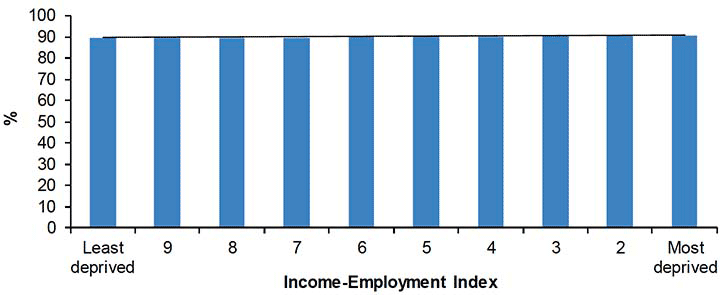
Trends in relative inequalities
Relative inequalities have been consistently low over the times series. The RII for 2019 is at 0.01, suggesting that there is no relative inequality for this indicator.
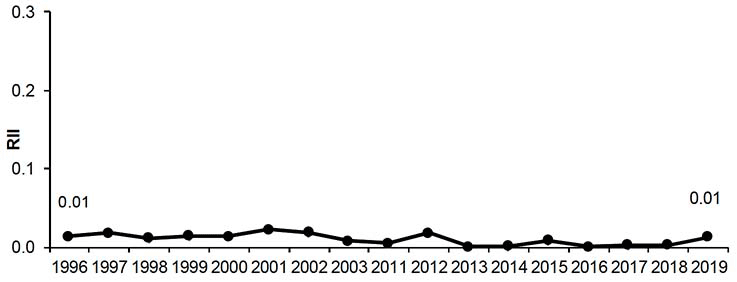
Trends in absolute inequalities
The absolute gap between the percentage of healthy birthweight babies in the most and least deprived deciles has been consistently low across the full time series (0.8 percentage points in 2019).
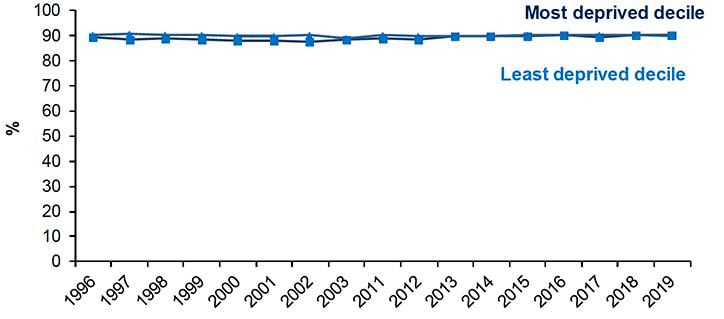
Self-assessed health
Trends in self-assessed health (adults aged 16+)
In 2018/2019 9% of adults rated their health as 'bad' or 'very bad', the same proportion as in 2016/2017. This is a significant increase from the start of the time series in 2008/2009 (7%).
| Year | Proportion of adults rating general health as bad/very bad | Lower 95% confidence limit (%) | Upper 95% confidence limit (%) |
|---|---|---|---|
| 2008/2009 | 7 | 7 | 8 |
| 2010/2011 | 8 | 7 | 8 |
| 2012/2013 | 9 | 8 | 9 |
| 2014/2015 | 8 | 8 | 9 |
| 2016/2017 | 9 | 8 | 9 |
| 2018/2019 | 9 | 8 | 9 |
Inequalities in self-assessed health 2018/2019
In 2018/2019, adults in the most deprived areas were seven times more likely to report poor health than those in the least deprived areas (21% versus 3%).
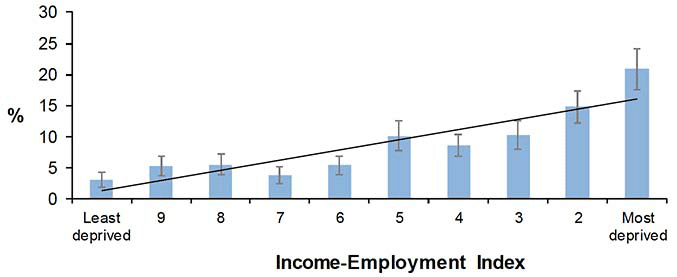
Trends in relative inequalities
Relative inequalities have fluctuated over the time series, peaking in 2014/2015 at 2.14. They have since fallen to 1.85 in 2018/2019, slightly lower than at the start of the time series (1.87 in 2008/2009).
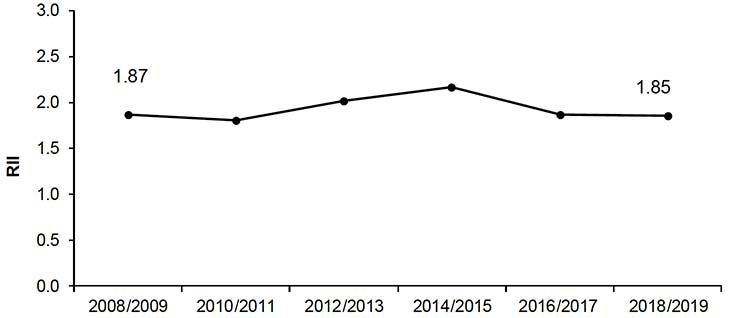
Trends in absolute inequalities
The absolute gap in the percentage of adults reporting poor health increased steadily between those living in the most and least deprived areas between 2008/2009 and 2014/2015 (from 13 percentage points to 19 percentage points). However, it decreased to 18 percentage points in 2016/2017 and 2018/2019.
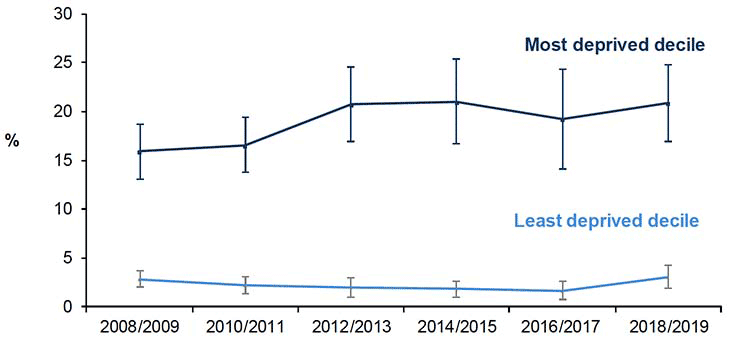
Limiting long term conditions
Trends in limiting long-term conditions (adults aged 16+)
A limiting long-term condition is defined as a physical or mental health condition or illness lasting 12 months or more that reduces an individual's ability to carry-out day-to-day activities.
In 2018/2019 34% of adults reported a limiting long-term condition. This is a significant increase from the start of the time series in 2008/2009 (26%).
| Year | Proportion of adults with a limiting long-term condition | Lower 95% confidence limit | Upper 95% confidence limit |
|---|---|---|---|
| 2008/2009 | 26 | 25 | 27 |
| 2010/2011 | 28 | 27 | 29 |
| 2012/2013 | 32 | 30 | 33 |
| 2014/2015 | 32 | 30 | 33 |
| 2016/2017 | 32 | 30 | 33 |
| 2018/2019 | 34 | 33 | 35 |
Inequalities in limiting long-term conditions 2018/2019
In 2018/2019, adults in the most deprived areas were nearly twice as likely to report a limiting long-term condition than those in the least deprived areas (47% versus 24%).
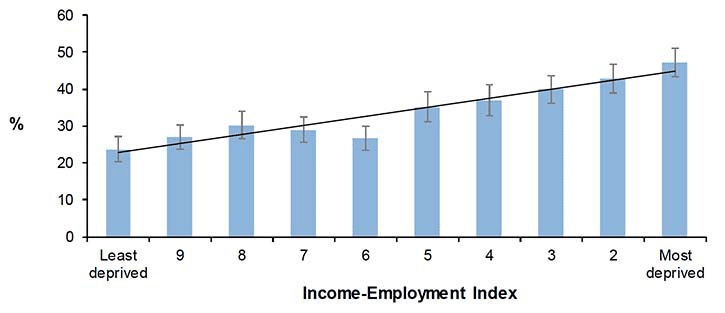
Trends in relative inequalities
Relative inequalities in limiting long-term conditions decreased between 2008/2009 and 2018/2019 from 0.83 to 0.72.
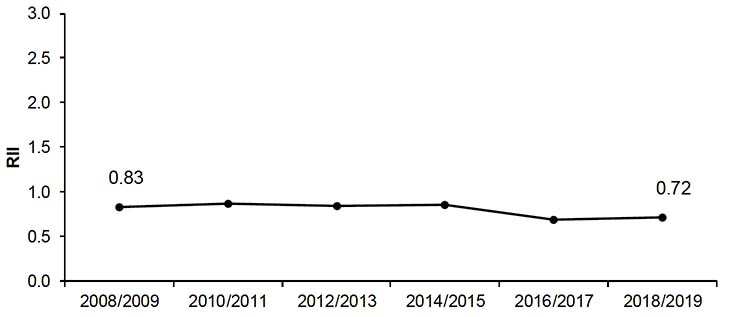
Trends in absolute inequalities
The absolute gap in the prevalence of limiting long-term conditions between the most and least deprived areas increased steadily between 2008/2009 and 2014/2015 (from 21 to 29 percentage points) before decreasing in 2016/2017 to levels similar to those seen at the start of the time series. It has since increased in 2018/2019 to 23 percentage points.
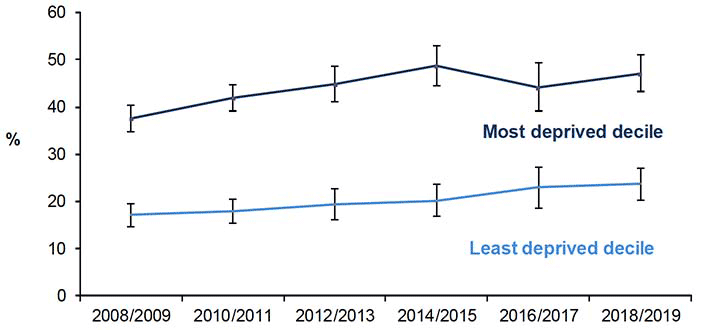
Drug-related hospital admissions aged under 75 years
Trends in drug-related hospital admissions
In 2018/19, over 10,000 individuals under the age of 75 were admitted to hospital for drug-related issues.
The rate of drug-related hospital admissions, which is based on the number of patients admitted to general acute and psychiatric specialties for drug misuse in each financial year, has shown a general upward trend since 1996/97 and is currently the highest it has been in the time series with 207.6 admissions per 100,000 population, compared to 64.0 admission per 100,000 in 1996/97.
| Year | Total admissions1 | Population | Rate per 100,000 (EASR) |
|---|---|---|---|
| 1996/97 | 3,366 | 4,754,906 | 64.0 |
| 1997/98 | 3,801 | 4,740,269 | 73.6 |
| 1998/99 | 4,395 | 4,729,975 | 86.1 |
| 1999/00 | 4,734 | 4,721,298 | 94.1 |
| 2000/01 | 4,851 | 4,708,667 | 97.6 |
| 2001/02 | 5,205 | 4,703,661 | 105.7 |
| 2002/03 | 5,412 | 4,701,958 | 110.7 |
| 2003/04 | 5,124 | 4,702,431 | 106.0 |
| 2004/05 | 5,292 | 4,714,233 | 109.8 |
| 2005/06 | 5,019 | 4,735,320 | 104.0 |
| 2006/07 | 5,262 | 4,752,425 | 108.8 |
| 2007/08 | 5,790 | 4,783,452 | 119.3 |
| 2008/09 | 6,120 | 4,811,453 | 125.9 |
| 2009/10 | 6,009 | 4,835,007 | 124.0 |
| 2010/11 | 6,435 | 4,858,058 | 132.6 |
| 2011/12 | 6,384 | 4,888,316 | 131.1 |
| 2012/13 | 6,033 | 4,895,114 | 124.5 |
| 2013/14 | 6,624 | 4,903,074 | 137.5 |
| 2014/15 | 6,981 | 4,914,362 | 144.7 |
| 2015/16 | 7,836 | 4,935,283 | 162.3 |
| 2016/17 | 8,607 | 4,962,391 | 178.4 |
| 2017/18 | 9,258 | 4,976,829 | 191.9 |
| 2018/19 | 10,017 | 4,983,364 | 207.6 |
1. Total admissions counts the number of individuals who have been admitted to
hospital for drug misuse in each financial year. Individuals admitted to hospital multiple
times in the same financial year will only be included once per year.
Inequalities in drug-related hospital admissions, 2017/18
In 2018/19, the admission rate in Scotland's most deprived areas was 18 times greater than that of the least deprived (644.0 cases per 100,000 compared to 35.2 per 100,000).
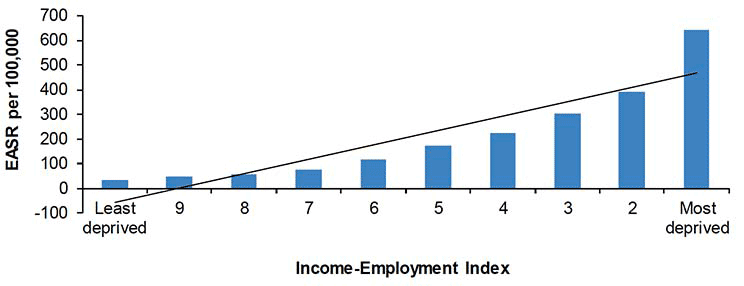
Trends in relative inequalities
Relative inequality levels for patients with drug-related hospital admissions have fluctuated over time. Although they have decreased from a high of 3.06 in 1998/99 the RII for 2018/19 (2.83) is higher than at the start of the time series (2.77).
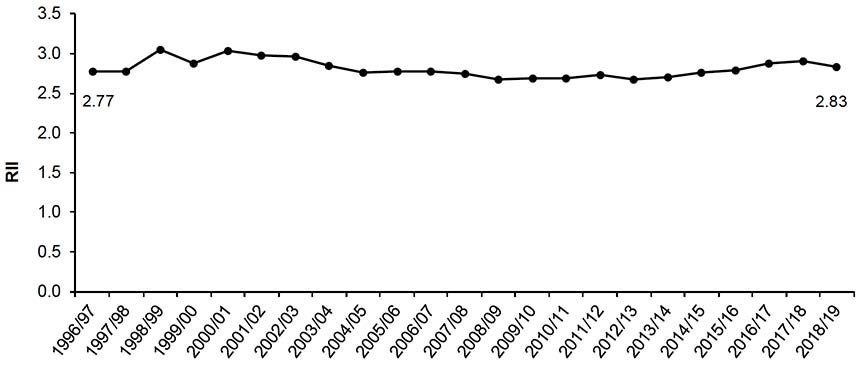
Since 1996/97 admission rates (aged <75) have ranged from 15-28 times higher in the most deprived areas compared to the least deprived areas.
Trends in absolute inequalities
The absolute gap in rates between those living in the most deprived areas and the least deprived areas has increased overall since the start of the time series. After an initial increase between 1996/97 and 1998/99 the absolute gap remained relatively stable, ranging from 309.6 – 384.7 per 100,000 between 1999/00 and 2012/13 before increasing in each of the past six years. In 2018/19 the absolute gap was at its highest level at 608.8 per 100,000. These fluctuations have mainly been driven by changes in drug-related hospital admissions in the most deprived areas, with drug-related hospital admissions in the least deprived areas also increasing but at a much lower scale.
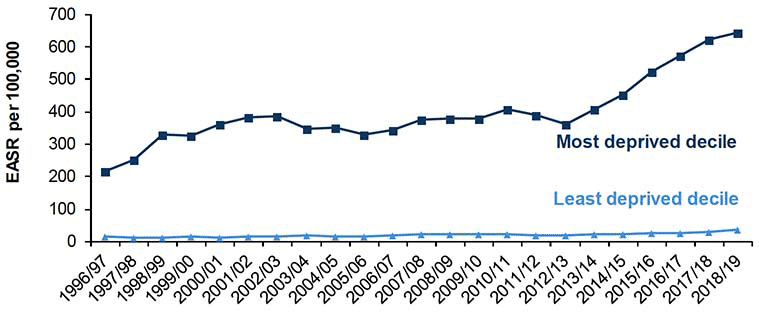
Contact
There is a problem
Thanks for your feedback